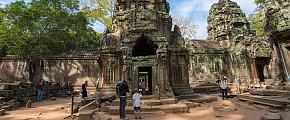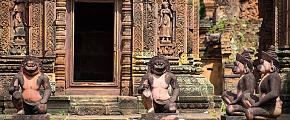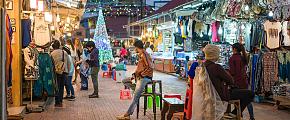Info and Tips for Photographing the Angkor Temples
For many, a visit to the Angkor temples in Cambodia is a once-in-a-lifetime trip that means lots of photos. For some travelers the standard "Me In Front Of It" photos will be OK. But if you are more serious about photography and wish to bring back stellar images of Angkor temples, some homework beforehand will prove to be helpful.
Best Times and Seasons for Angkor Photography
Sunrise and sunset are the standard good times of the day for getting good shots of Angkor temples. At sunrise, the dramatic light and quiet surroundings offer a chance for stunning photos. Between the hours of 8 am to 10 am and 4 pm to 5 pm, the light can be still good but temples are often crowded with huge tour groups. In the middle of the day, the sunlight is very strong in Cambodia and only suitable for shooting details. At sunset, it is great to photograph the temples when they are bathed in warm yellow light.
Be aware that sunrise/sunset is very early in Cambodia and it takes time to get to the Angkor area from the city of Siem Reap where you base yourself. My suggestion is to ask your guide or hotel the approximate time the sun will rise/set that month and head out at least 30 minutes beforehand.
Speaking of the time of the year, I know that generally, the dry winter months (November to February) are the peak time for Angkor Wat photography for the higher chance of sunrise being seen. During the wet monsoon season, there are many rainy or overcast days in Cambodia, and basically no sunrises. Nevertheless, I should indicate that such weather and time information is not absolute. In fact, many travelers headed to Cambodia in July and August and still made some nice images of Angkor temples. Plus, you are more likely to get dramatic cloud formations and lush foliage in the rainy season.
 Sunset at Angkor Wat
Sunset at Angkor Wat
Best Spots for Shooting Sunrise/Sunset
If you are planning on sunrise and sunset shots of Angkor temples, here are some recommended good spots to head to.
Sunrise & Sunset at Angkor Wat
Angkor Wat is the primary place for sunrise shots. It faces the west. The best location for shooting sunrise over Angkor Wat is on the left side of the walkway while still on the edge of the Reflection Pool facing the temple spires. Arriving early helps your chances of getting a nice reflection on the pond with silhouettes of temple spires (you know, the classic 'pond shot'). You can also approach the temple from behind and get shots of the temple facing the sun.
Note: The gates to Angkor Wat open at 5 am, and you need to count on getting there early to secure a good place before the throngs sweep in. Generally one needs to leave the hotel early at 4:30 am, drive to Angkor and walk through the gateway to the inner reflection pool.
Angkor Wat is a great place to sunset shots too. Plan to be there by 3:30 pm. By 5:30 pm the sun has set and by 6 pm the light is gone. The upper terrace of Angkor Wat will be the vantage point for sunset shots.
Sunrise at Ta Prohm
This is the spot where some of the Tomb Raider scenes were filmed. There are crumbling ruins, carvings, and gigantic colossal tree roots to shoot. As the sun filters down through the trees, some unusual pictures can be taken. Arrive around 6:30 am and you can have it entirely to yourself for the first hour or so.
Sunrise at Srah Srang
The ancient royal reflecting pond of Srah Srang can offer a colorful sunrise view. As the sun rises above the trees on the edge of this large square water pond, the lovely reflections on the tranquil water can lead to some picturesque photos. Plus, it is less crowded than Angkor Wat.
Sunset at the Bayon
This temple located within Angkor Thom is breathtaking at any time of the day, but even more so at sunset. Climb up the top of the temple to shoot soft and warm light after 4:00 pm, and there will be grand scenes filled with the ever-present 'Smile of Khmer' on the stone faces. You will share this location with some other people, but with some thoughtful composition, you can isolate the subject you want to stand out and not have people appear in your frame.
Sunset at Pre-Rup Temple
The Pre Rup (also known as Pyramid Temple) outside Angkor Thom is also great for sunset shots. The beautiful rusty-red hue of sandstone used in the construction can be enhanced by the sunset glow and provides a brilliant contrast to the lush green of the jungle in the distance.
Sunset at Phnom Bakheng
Phnom Bakheng is known for its sunset view. The sun is setting over the jungles. Angkor Wat and other temples are out of sight as they are far away. When shooting photos here, do not focus on the sun and the sky, including other elements such as the temple spires or tourists, will provide both interest and a sense of the place.
Note: Phnom Bakheng is the most visited temple at sunset. If you opt for Phnom Bakheng for sunset, be sure to arrive plenty of time beforehand. And if you arrive at the temple at the top of the hill after 5.30 pm, you might be refused admission.
Other Photography Locations
There are over 1000 temples in the Angkor area. Many of the other temples are almost as spectacular and interesting to photograph as those mentioned above. The beautiful Bantay Srei, for example, has gorgeously red-colored stones and some of the prettiest carvings in the complex. The less-visited Beng Mealea offers chances to shoot photos that exclude a feel of decadence and solitude to them.
Photo Equipment Suggestions
Not all great images of the temples are captured with expensive equipment, but they can make contributions to better photos.
Tripod
When shooting sunrise and sunset, you should always set up your camera ahead of time because you never know exactly when the magic time will be. A good tripod can ensure you are set up and ready when the light is right.
Lens Cloth
A good cleaning cloth is essential because the heat and humidity of the temples amid jungle can cause a fogging on your camera lens.
Split Neutral Density Filter
A problem when taking photos of Angkor temples is that the sunlight is very strong and the sky is often very bright while the temples are often shady. The extremes of light and dark can spoil an otherwise good shot. Meanwhile, because the temples are often crowded, you are limited in the viewpoints you can use and time you can take photographs, making it difficult for you to get the light you want. A split neutral density filter can help reduce the contrast of light.
Wide-Angle Lens
When on the grounds of the temples, a wide-angle lens will help capture the whole structure.
Zoom Lens
A zoom lens is helpful for you to frame the details in the architecture such as carvings and bas-reliefs.
Tips for Taking Successful Photos of Angkor Temples
(1) Have a Local Guide
For most shutterbugs from outside the Angkor area, having a local guide is important in order to access those photographic spots and get to the vantage points at the right time.
(2) Wait Longer
We all know that sunrises and sunsets can provide dramatic colors in the sky. But few realize that if we keep shooting after the brightest color seems to fade, a richer hue of the colors may appear. This is even true when taking sunset shots. Wait for some 10 to 20 minutes after the sun has risen or sunk down, chances are you will see beautiful afterglow that renders beautiful photos.
(3) Approach the Temple With the Light Behind You
When shooting the temples, it is important to approach them with the sun behind you so that the stones are beautifully lit. Try to avoid backlighting unless you want a silhouette.
(4) Don't Forget the People
Good travel photos involve not just landscapes but also people. The Angkor area is surrounded by interesting people. Monks in their orange robes, running kids, and even street peddlers can all make colorful subjects for photography. When doing a portrait, pose your subject in soft light and avoid direct sun on faces, which minimizes squinting eyes and high-contrast shadows and allows the subject to relax and the eyes to communicate.
Note: Be sure to ask permission for shooting portraits. Local people will usually be happy to have their pictures taken. Be aware that the children in the area may beg for money or be charged for taking their portraits. For child beggars, it is suggested to give out some candies or toys rather than money. Giving out money will encourage them to beg.
(5) Consider Using White Balance to Enhance Color
At times, the overall color that appeared in our camera doesn't look as much rich and impressive as it actually is to our eyes. Change your White Balance setting to Daylight, and a richer hue of the color will appear in your image.
(6) Be Unique
Nobody takes a bad picture of Angkor. But many of the pictures we saw, either on the web for in books, look identical. So try different vantage points and angles to find the most interesting composition.
(7) Be Considerate
If a temple is overrun with tourists, look around before you move to a spot and start shooting, in case you might break other people's frames. Also, do not hog the view of a particular scene so that other visitors can enjoy and photograph it too.
Odynovo (formerly Odyssey) offers tailor-made tours to Cambodia. If you wish to have more detail about photography in the Angkor area or want to experience a photography tour with us, reach me directly at trip@odynovotours.com. Share this to help other travel fellows who may appreciate that!
Quick Question
What Our Clients Say About Us
Posts Update
SUBSCRIBE TO WIN A FREE TOUR
Subscribe to our newsletter for a chance to win a free 7-day Morocco tour! And more insider travel news, exclusive offers, and inspiration will be sent straight to your inbox.







